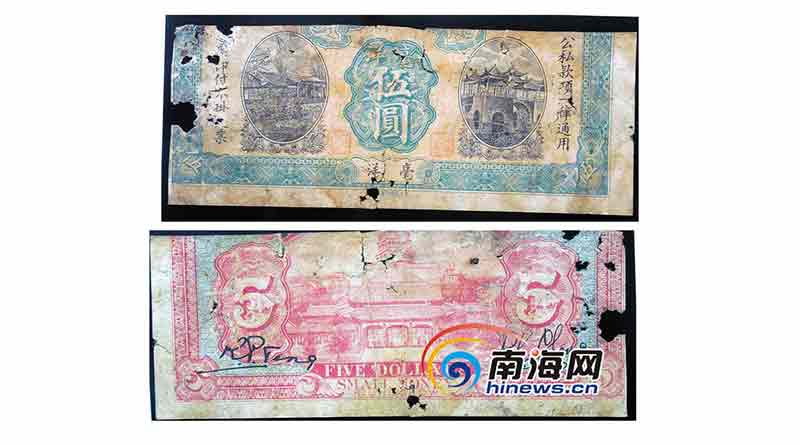In 2008, Haikou’s Historical Downtown was selected as one of China’s most Famous Historical and Cultural Streets. When mentioning the arcaded semi-colonial streets of old Haikou, it is impossible not to also mention Cantonese Warlord Deng Binchen. During his time on Hainan Island he set up the South Kwongtong Industrial Bank which began issuing paper bank notes.
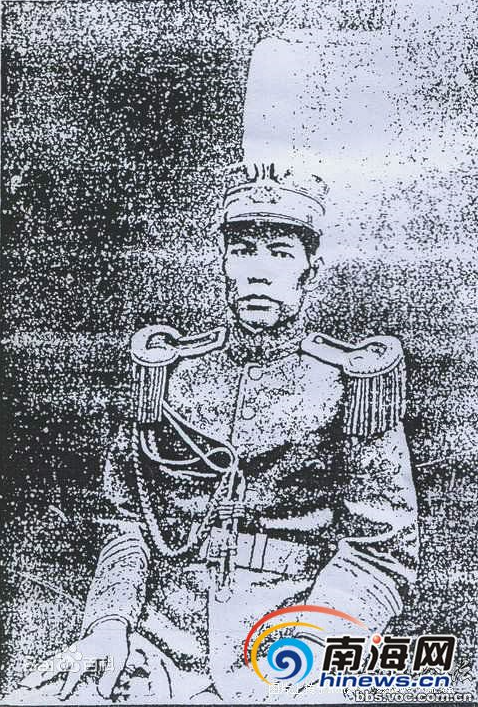
Cantonese Warlord Deng Benyin
When Deng established the South Kwongtong Industrial Bank, he was building the first modern bank in Hainan and the first bank in Hainan to issue paper banknotes. Whether you are specifically talking about the history of currency in the areas near to the South China Sea in local currency or are doing generalised research into the history of our national currency, these banknotes are of great importance.
Numismatic and antiques collector Wang Fuhe has collected many examples of paper banknotes from the Republican period and earlier. According to him the earliest of the Hainan provincial banknotes are those which were issued by the South Kwongtong Industrial Bank. They also very hard to acquire.
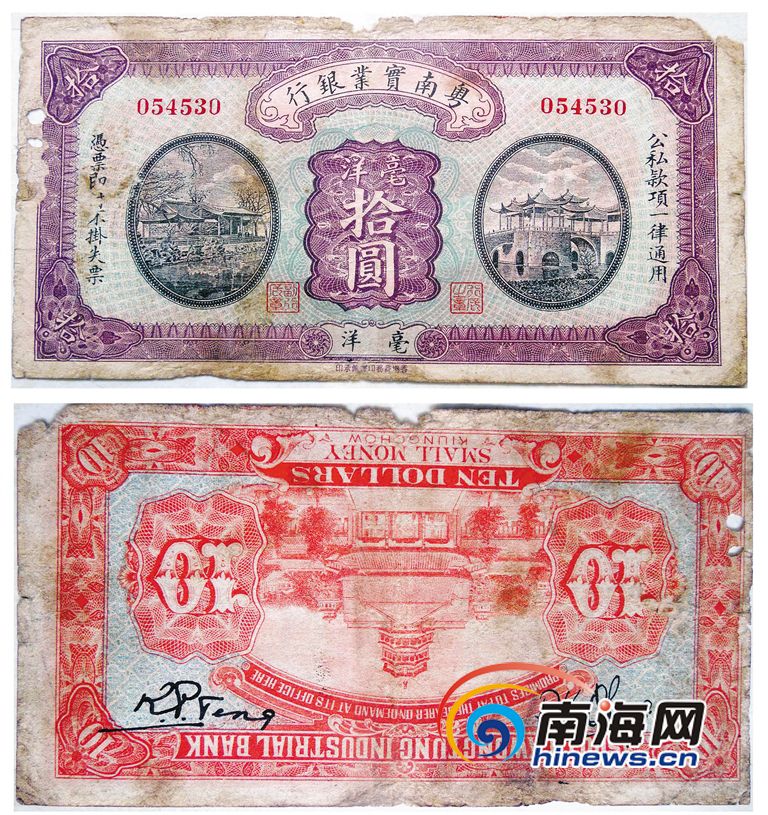
Printed on the back are the words “1 Yuan” Small Money
Wang Fuhe has five paper banknotes. These include a small one yuan, a large one yuan, a small five yuan, a small ten yuan, and a large ten yuan. According to people who travel in the world of coin collectors, there ought to also be a large five yuan, but none are known to exist. There should also be a fifty and a one hundred which, to date, also have not yet been found.
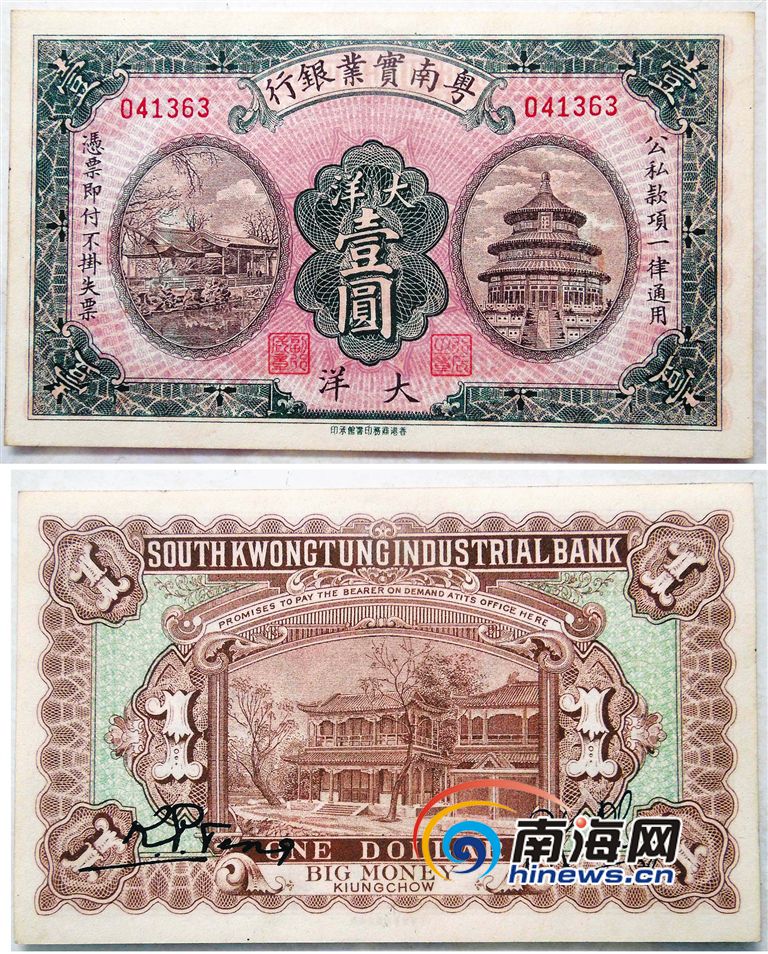
1 Yuan Big Money
Beautifully printed and attractively presented
Wang Fuhe’s favourite banknotes are extremely well decorated and beautifully printed.
At the top of each banknote, the words “South Kwongtong Industrial Bank” are written in Chinese (on the front) and English (on the back). “Promises to pay the bearer on demand at its offices here” is written below the English name of the bank on the English language side and vertically on the left and right on the Chinese language side. “Printed by the Hong Kong Commercial Press” is in very small type on the Chinese side only. different kinds of money are divided both by sum and type with there being both Big Money and Small Money. Kiungchow, one of the names for Hainan, is also written on the English side.
The one yuan bank note is 13.5cm by 8cm. On one side the edges are dark green with the formal bank character for the number one inscribed in each of the four corners. The central part of the bill is pink and has pictures of Suzhou and the Temple of Heaven. Finally, the number one in bank characters is inscribed in green at the centre. The reverse side of the bill is primarily brownish with ‘one’ written in Arabic numerals in each corner in such a way that mirrors the Chinese design. The text in English also mirrors the meaning of the Chinese text on the other side. The picture at the centre is of an unidentified building. The bank president R.P. Feng’s signature in English is in the lower left hand corner.
The one yuan note of small money is green on one side and blue and yellow on the other. The pictures are the same as the big money note. With the exception of changing the words “small money” or “big money” and the colour schemes, the two notes are otherwise the same.
The ten yuan note is 16.5cm by 8.8cm. Primarily dark green and orangish, the buildings in the picture are of the Suzhou’s garden landscapes and the famous west lake bridge from Hangzhou. The rear of the note has a picture of the Fragrance of Buddha Pavilion at the Summer Palace in Beijing.
On the small money ten yuan note, the colours are purple and green and red and blue.
The patterns front and back of the different notes use repeating motifs.
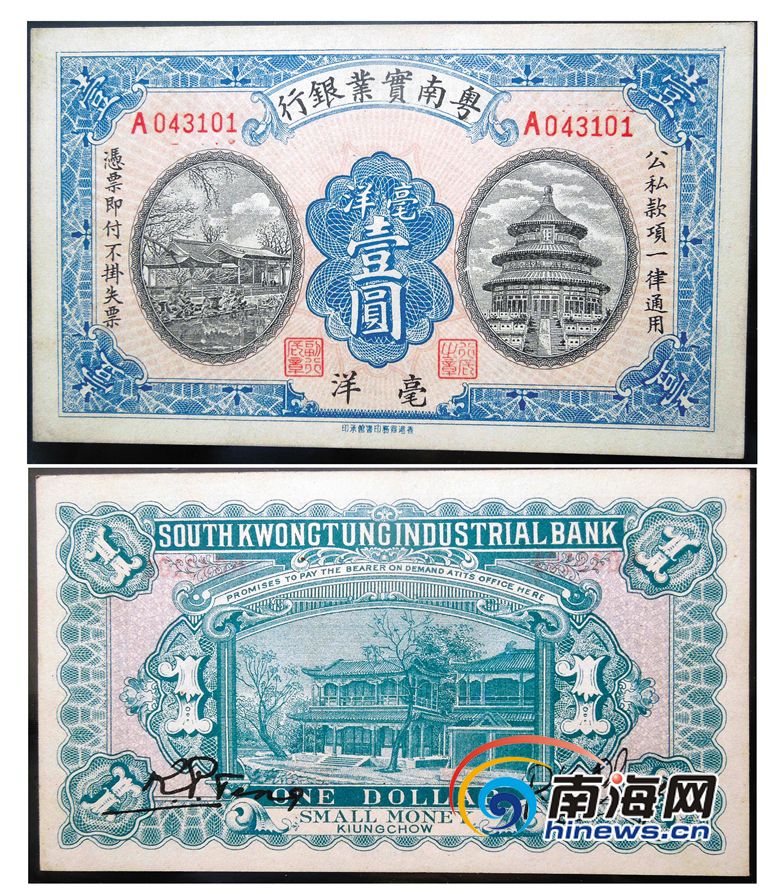
1 Yuan Small Money
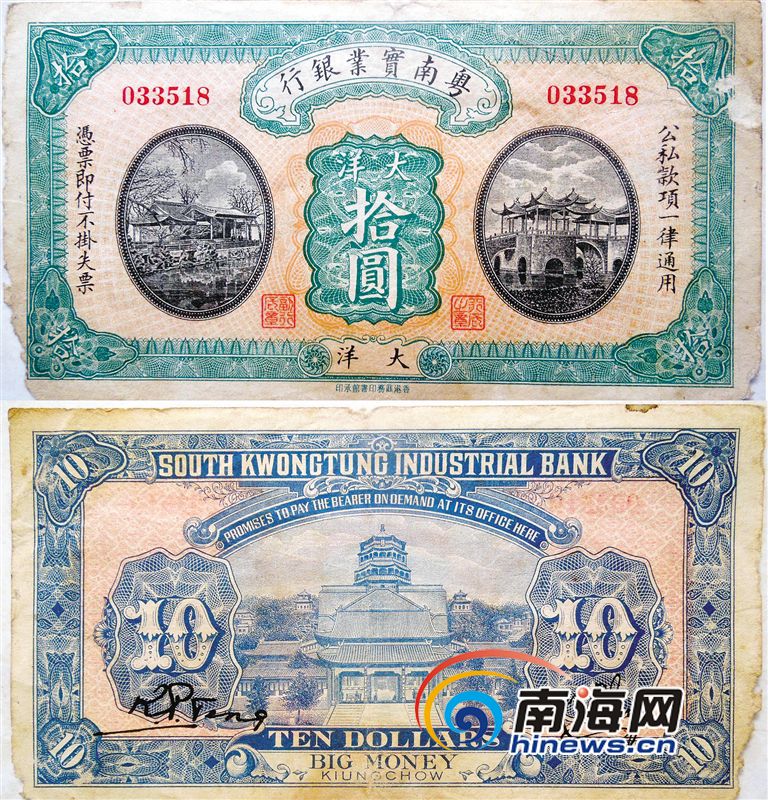
10 Yuan Big Money
Loss in value
According to Wang Fuhe, because the five yuan note is damaged, it is not worth as much as a full note in good condition would be. He actually damaged the note himself when he was a child.
At that time, the note was in his father’s collection. He was looking through the drawer for some small change to buy snacks when he saw the “five yuan” small money note. His mother saw it and said ‘that worthless thing cannot be used’. As a result, the young Wang Fuhe took a pair of scissors and cut off the part of the note which read South Kwongtong Industrial Bank. When his father went home, after the discovery of what had been done, he thought it was done by Wang Fuhe’s older brother and he beat his other son.
At present, in all of China, there is only one five yuan small money note that is known to exist. Like Wang Fuhe’s, it is damaged. It belongs to a collector in Zhanjiang. Notwithstanding the fact that his note’s damage was caused by him, he still considers it to be a precious treasure.
Wang Fuhe’s small ten yuan note is the only one known to be in existence. More than 20 years ago, he used 10,000 yuan which he had earned from selling a house to buy this note. At that time, people said he had wasted money on buying old and useless paper. This story is legendary within the coconut city’s community of collectors.
This banknote is especially unique because it has a printing error on it with one side being printed the wrong way up.
“The habit of printing banknotes with the obverse facing one way the reverse facing the other way has long been common. Because of the location of the bank president’s English signature, it can be confirmed that printing in this way was an error.” Wang Fu said.
At that time, it’s obvious that more than one sheet would have been printed incorrectly. If a person then went to the bank counter to exchange it for cash money, he would have been told to go away. In Fucheng, a man surnamed Wu had some old notes for sale but he didn’t know where to sell them. Wang Fuhe and another man from Fucheng by the name of Huang Zhansheng bought the precious old notes.
Experts Wu Chouzhong and Liu Linzhang who study historical banknotes can confirm that the South Kwongtong Industrial Bank banknotes were circulated in the marketplace.
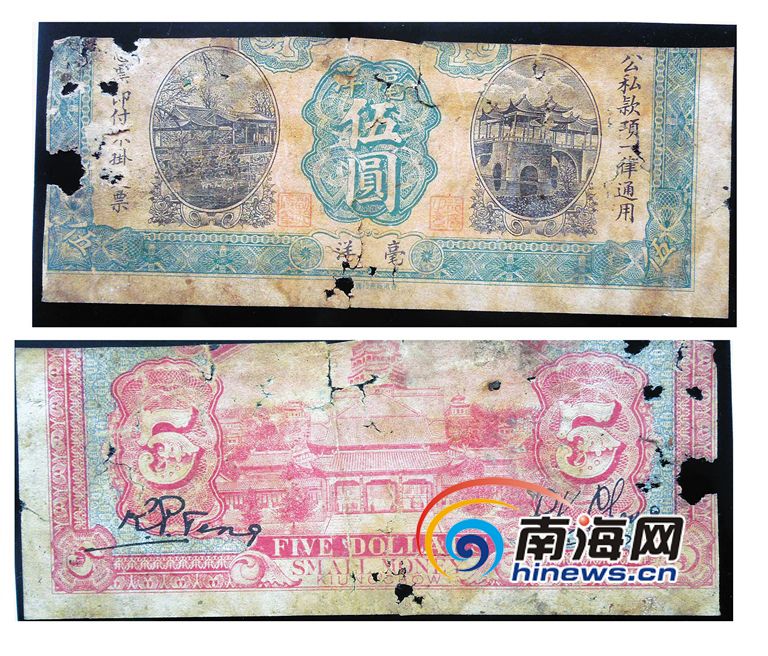 A damaged 5 Yuan Small Money Bill
A damaged 5 Yuan Small Money Bill
A flash in the pan
According to historical records, the South Kwongtong Industrial Bank was founded in Haikou in 1925 by Cantonese warlord Deng Benyin. The paper banknotes were intended to help open up trade in the South China Sea region. By early 1926, however, Deng Benyin had been expelled from the island by Nationalist troops. The South Kwongtong Industrial Bank was closed. The large money and small money banknotes were cancelled. Because the South Kwongtong Industrial Bank was only open for such a short time, there wasn’t much opportunity for increased stock of notes to be issued or to become common.
The South Kwongtong Industrial Bank banknotes which were issued by Deng Benyin were used in the eight areas which he had control of (namely Gaozhou, Leizhou, Luoding, Yangjiang, Yinzhou, Lianzhou, Qiongzhou, and Yazhou). These notes of various denominations could be found in many cities and counties throughout Hainan Island and also in Zhanjiang on the mainland. Many elderly people in Hainan also confirmed that they had previously seen or used these notes.
According to what one elderly person recalls, when the banknote was issued a large money note was equal to one silver dollar and a small money note was equal to one tenth of that value. In reality, however, because the exchange rate was not fixed, it might be eleven or twelve cents instead.
In 1923, Chen Jiongming appointed Deng Benyin as one of his eight commanders and gave him control over parts of southern China ranging from Gaozhou and Leizhou in the north to as far west as Guangzhou. However, Chen Jiongming soon found himself losing ground. Deng Benyin quickly had to abandon Qinzhou and Lianzhou. Eventually, he was left with only Hainan.
However, by January 1926, the Nationalist army of Guangzhou liberated Hainan from the warlords. After this, Deng Benyin fled to Vietnam. Then he went to Shanghai. After that, it is a mystery as to where he went. Some people think that by the time the banknotes had made it to Hainan, the bank had already been closed and the notes were already worthless.
History of Banknotes in Hainan
According to records in the annals of Hainan Finance, Hainan has had banknotes since 1914. They were first issued as “vouchers” which could be used “just like cash”. The original notes had the year 1913 printed on them with “Qiongzhou” stamped on the left and right. Depreciation was immediate and by 1917, they were worthless.
When Deng Benyin came to Hainan in 1924 and set up the South Kwongtong Industrial Bank, because his “small money” was of such small value, many merchants and businesses refused to use it. In 1926, when he was removed from Hainan, the Nationalist government offered to buy South Kwongtong Industrial Bank banknotes at half of face value.
In 1926, the central bank of Guangdong Province issued a Haikou note. But, two years later, they recalled it.
In 1939, paper banknotes issued by the Guangdong Provincial Bank were inscribed with Hainan Area and “only to be used in Hainan”. They were stamped with the seals of Wang Yi and Wu Daonan. Then, in 1940, those notes were stamped by Wang Yu and Qiu Yuesong.
During the Japanese occupation of Hainan, they also issued paper “military cash vouchers”.
In 1949, shortly before the Nationalists fled from Hainan, the Bank of Hainan issued another set of paper notes but they were weakly backed and never became popular.


